Report on the attractiveness of video game heroines and heroes Part 2/2
- 17 czerwca, 2020
- Michał Dębek
- Female heroes and male heroines: the gender of protagonists
- Stimulating heroes
- Heroes who didn't stimulate the participants
- Stimulating heroines
- Heroines who didn't stimulate the players
- Which character engaged women, and which engaged men?
- Where did the subjects’ gazes wander?
- Do the virtual preferences coincide with real-life preferences of the respondents?
- The must-have features of attractive heroes and heroines
In the first part of the report on the attractiveness of video games heroes and heroines, we discussed the canons of beauty and heroism. We also presented an attractiveness ranking of popular video game characters. What will you learn from this part? Firstly, we will investigate how game characters excite and engage players. Secondly, we will analyze how the attraction to female and male video game characters differs from people’s real-world preferences. Finally, we will offer a set of must-have physical features and personality traits that make a video game hero and heroine attractive.
Female heroes and male heroines: the gender of protagonists
Gender is the so-called cultural, social and psychological condition of being male and female. It’s a set of features and behaviors which, at a given point in time, are qualities associated with men or women. For example, contemporary Poles believe that „professions such as driver, programmer and engineer are not created for women, and that a director should be a man.” In turn, an interior designer, pharmacist, social worker, receptionist or nurse are all seen as „typically” female occupations. As a result, every Pole, from generation to generation, is taught the qualities which make a „real man” or a “real woman.”
Therefore, a biological man may not always be perceived as masculine. Depending on the characteristics and behaviors he demonstrates, a male hero may be perceived as more or less masculine, or… feminine. A gentle, helpful, caring and empathic man will probably not be considered manly in Western culture (whether we like it or not). The female heroine will not always be perceived as feminine just because she is a biological woman. In short: the perception of masculinity or femininity of a hero or heroine can be affected by the specific gender role they take in the game, e.g. Joel from The Last of Us is cast in the father role, and Lara Croft is a fearless warrior.
To investigate how players perceive the protagonists’ femininity and masculinity, we created a psychological gender index. The index took into account the gender roles demonstrated by the characters in cultural, biological and social context, and was based on Bianca Grohmann’s method for measuring masculinity and femininity.
The index allowed us to place every gaming hero and heroine on a gender identity scale, ranging from extreme masculinity to extreme femininity, and with gender neutrality in the middle. Thanks to this, we identified feminine and masculine heroes, and as feminine and masculine heroines.
Masculinity of heroes
The most masculine heroes in games:
⦁ Geralt (The Witcher)
⦁ Ezio (Assassin’s Creed)
Each of the male characters who achieved a high score in the masculinity index also ranks in the TOP 3 most attractive video game characters.
Femininity of heroes
The most feminine heroes:
⦁ Lucian (League of Legends)
⦁ Joel (The Last of Us)
Femininity of heroines
The most feminine heroines in games:
⦁ Kokoro (Dead or Alive)
⦁ Lara Croft (Tomb Raider)
Like the heroes, both characters are also made it to the TOP 3 of the attractiveness ranking.
Masculinity of heroines
The most masculine heroines:
⦁ Juri (Street Fighter)
⦁ Christie (Dead or Alive)
The above results, combined with the ranking of attractiveness from the first part of the report, led us to the conclusion that
the most attractive game characters are usually those whose perceived gender is consistent with their biological gender.
The attractive characters Geralt of Rivia, Ezio Auditore and Hitman simply exude masculinity. Kokoro, who tops the beauty ranking, was also perceive undoubtedly feminine. The exception here is Lara Croft, who in spite of being cast in a stereotypically male role – is still perceived as an attractive, feminine woman.
How is it that the brave Lara Croft and infantile Kokoro are considered equally feminine? Lara Croft could be assessed as feminine by the female subjects (women understand femininity as a strength). For men, Kokoro is the one who’s seen as feminine (i.e. a woman who can be looked after).
Stimulating heroes
Geralt was the most stimulating male hero. Both men and women reacted to the Witcher with distinct changes in electro-thermal activity (see how we study the stimulation and engagement of players). We observed particularly high levels of stimulation in the moments when Geralt’s face was in close-up. The players’ eyes were drawn to the veins around the neck and the character’s movement in a dynamic combat scene.
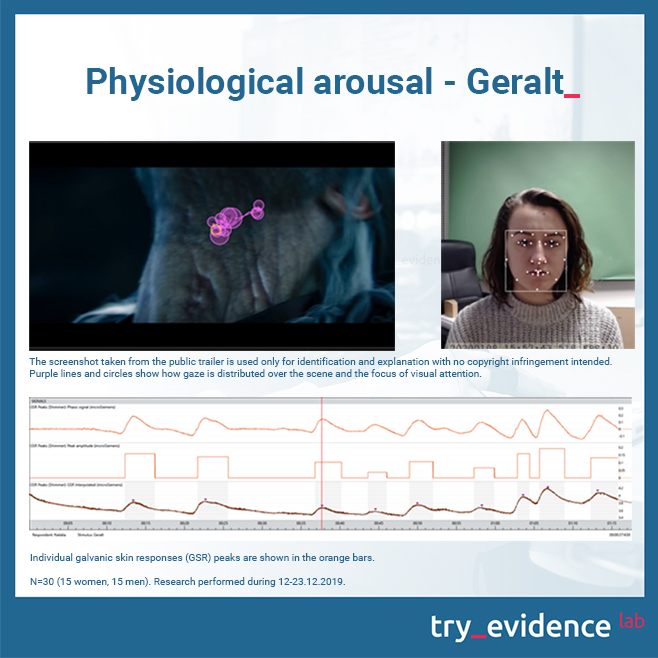
What could this result from? It is possible that players reacted emotionally because they saw the hero in imminent danger.
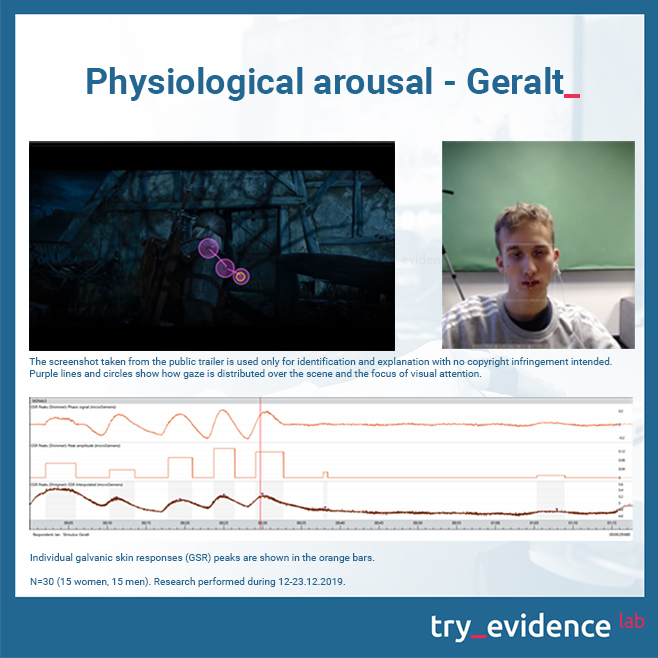
While watching the trailer, the opening and closing subtitles also triggered a reaction. What does it mean? The Witcher is desirable not only as a hero of the game, but also as a brand. Just reading about the Witcher activates in the subjects a desire for the game. The brand brings up the story, emotions, associations, and maybe also memories. By tracking the arousal levels and eye movement of the subjects, we knew that our subjects actually read the words and paid attention to them.
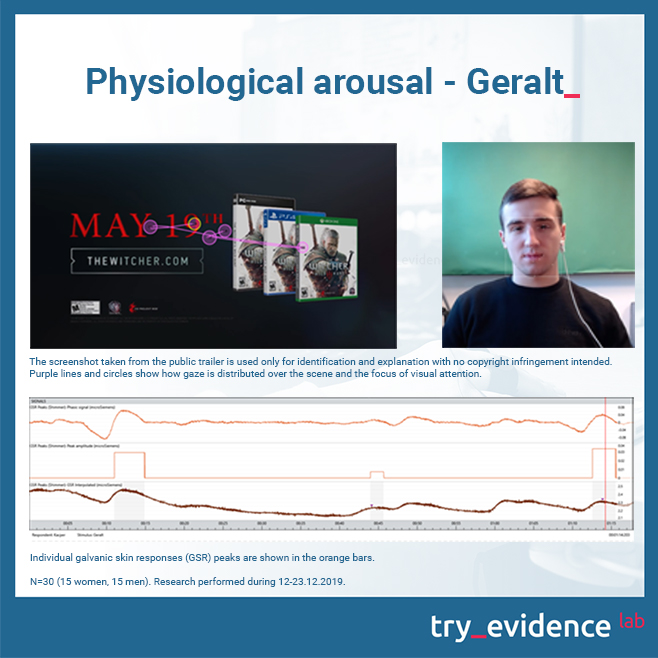
Heroes who didn’t stimulate the participants
Joel from The Last of Us turned out to be the least stimulating hero. The trailer still included moments of strong engagement of the respondents. Joel was rated as the least masculine in the gender classification, and the trailer portrayed him as a guardian and defender. This put him into a stereotypically feminine role, which could have prompted the subjects to rate him as a feminine hero.

Hitman was considered equally unstimulating by both sexes. Interestingly, some scenes involving Agent 47, according to the software we use, however, involved women. Specific parts of the Hitman trailer activated the facial expressions of the women surveyed, which the software „recognized” as engagement. The agent, however, failed to trigger significant skin-galvanic reactions or increased heartbeat in women. We call this combination of phenomena “shallow player engagement”, a reaction mainly associated with cognitive experiences – thoughts, rational assessment, but not necessarily with real, deep emotions.
Stimulating heroines
Kokoro was by far the most stimulating for both sexes. At the same time, high arousal probably had a completely different quality for each sex. We checked it by analyzing nonverbal emotional expressions.
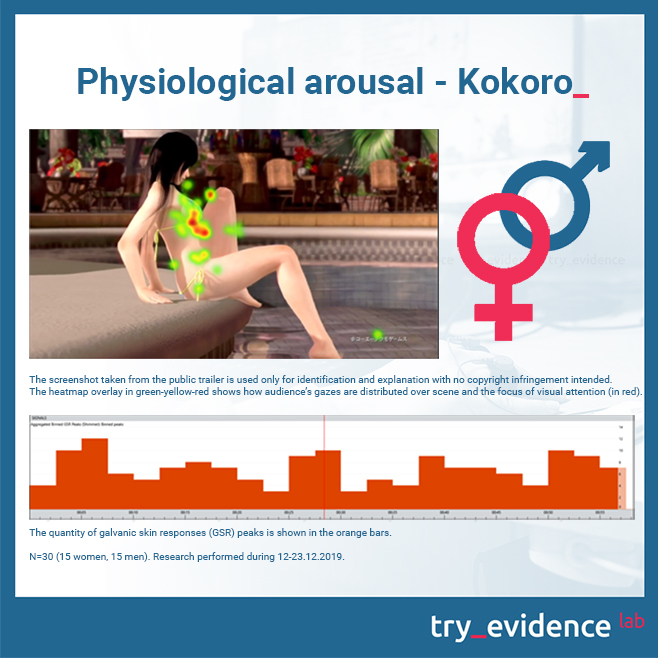
Unfortunately, the surveyed men showed their emotions very sparingly – only a few of the respondents showed significant mimic changes. Although we know many of them were strongly stimulated by Kokoro, we are not sure about the character of the stimulation.
The players were stimulated by various scenes, such as the ones where Kokoro is sitting on the beach and on the edge of the pool. Even the first appearance of the heroine was stimulating for the players.
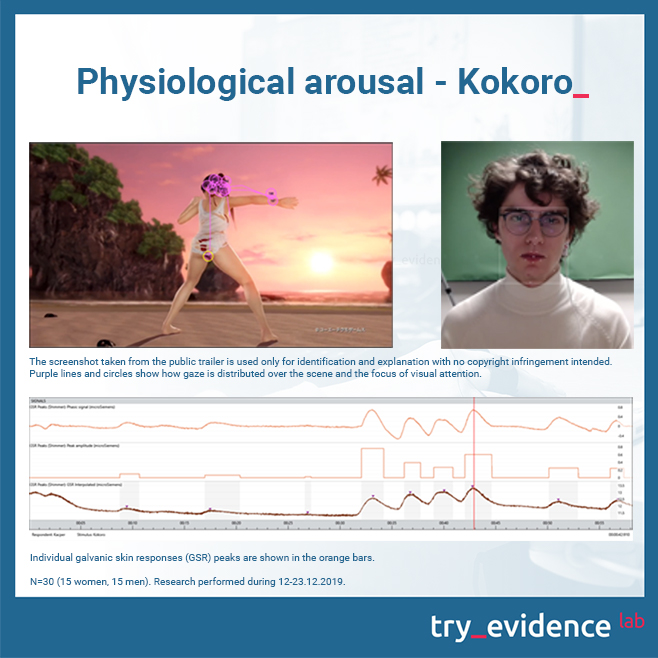

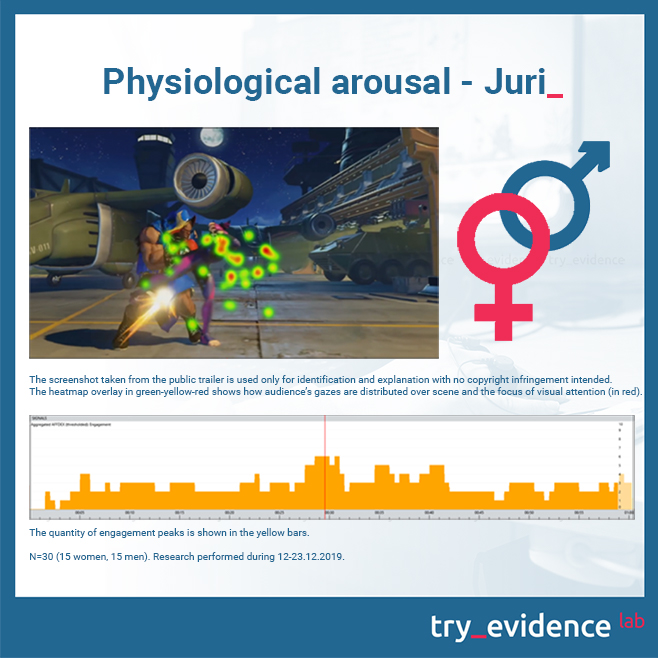
While watching Juri, the subjects were especially stimulated by close-ups on the bust, fight scenes, as well as the scene just before the knock out, and the close-up on the heroine at the end.
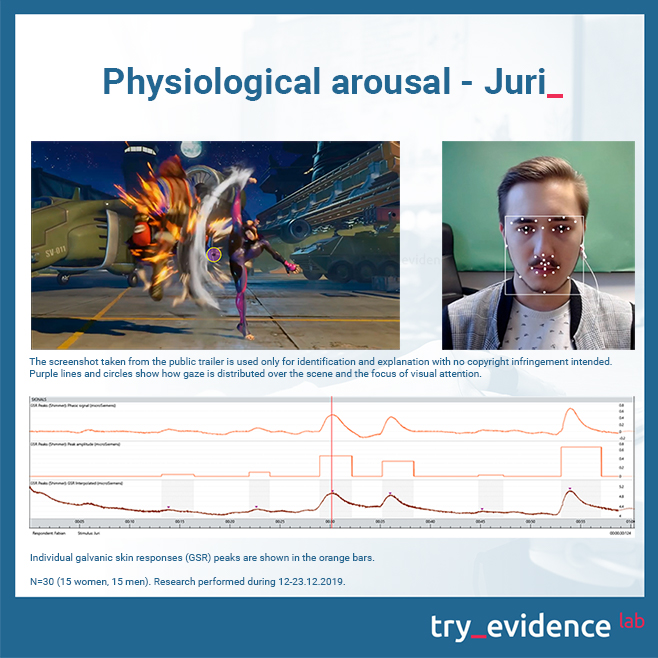

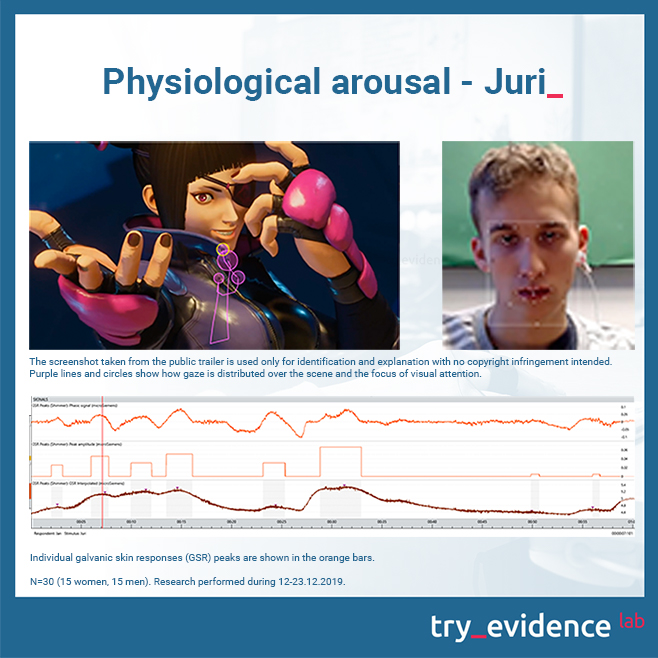
Heroines who didn’t stimulate the players
Lara Croft stimulated the male subjects the least. Women, on the other hand, were the least aroused by Christie. Faith Connors was another character which failed to arouse either sex. The trailer with her was the least engaging of all heroes and heroines’ performances
Which character engaged women, and which engaged men?
For women, the trailer for The Witcher was the most engaging. Men, on the other hand, were more engaged by Ezio. However, the level of engagement was lower here than when watching any other trailer featuring a female heroine as the main character.
Zhin and Hitman were the least engaging for both women and men. Agent 47 caused the most divergent reactions between the genders. For example, the scene showing Agent 47’s getting dressed caused great engagement in women. At the same time, the scene hardly engaged men at all.
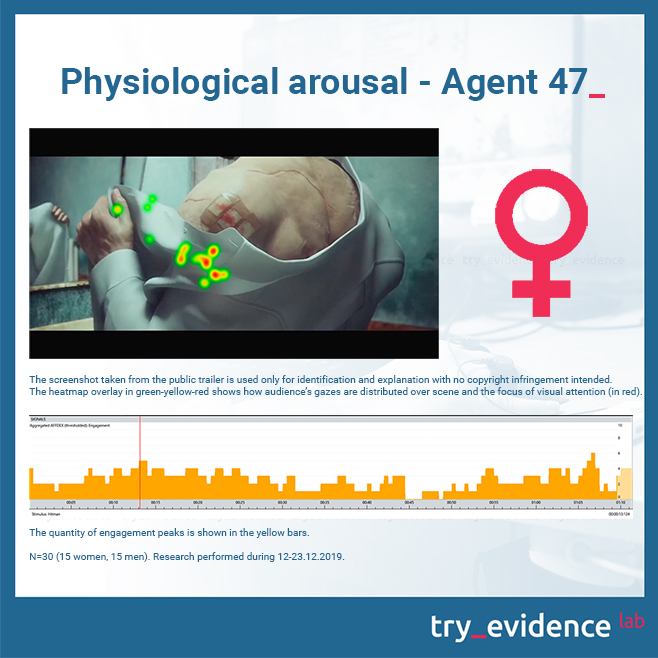
Although Lucian clearly stimulated both sexes, the reactions of men and women showed different levels of engagement.
The romantic scene with his beloved caused both arousal and engagement in women.
Men, however, differed from women in that despite being aroused by the love scene, they did not show external signs of engagement – „poker faces” prevailed.
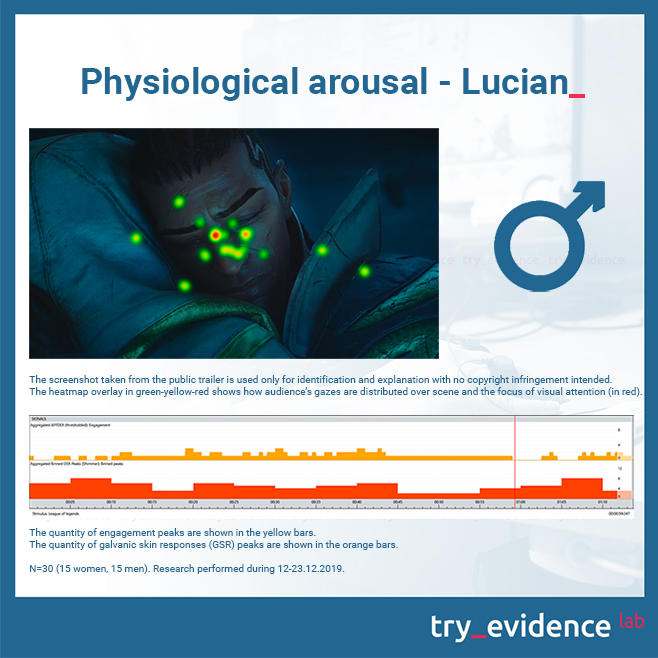
Kokoro engaged women the most. In turn, men showed the greatest engagement when watching Juri. However, no matter which heroine was shown on the screen, men’s engagement was less pronounced than women’s.
Men’s engagement remained high during fighting scenes and declined afterwards.
Lara Croft was the least engaging for men. Women, on the other hand, were the least engaged by Mile.
Faith Connors was another character who failed to engage players (incidentally, Faith was also not very stimulating). The trailer with her was the least engaging of all heroes and heroines’ performances.
Where did the subjects’ gazes wander?
Eye tracking revealed that women frequently, and for long periods of time, fixed their eyes on the heroines’ abdomens. This can be a sign of competitive tendencies or mere social comparisons. Or, perhaps, it simply shows that women seek pleasant, aesthetic sensations? This tendency was evident mainly when women watched Lara Croft and Christie Monterio. Although less pronounced, this tendency was also seen in the reception of other heroines.
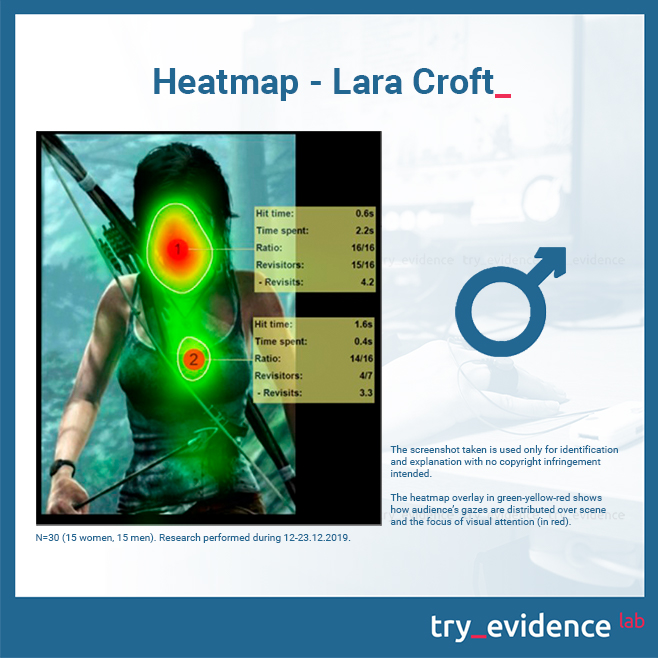
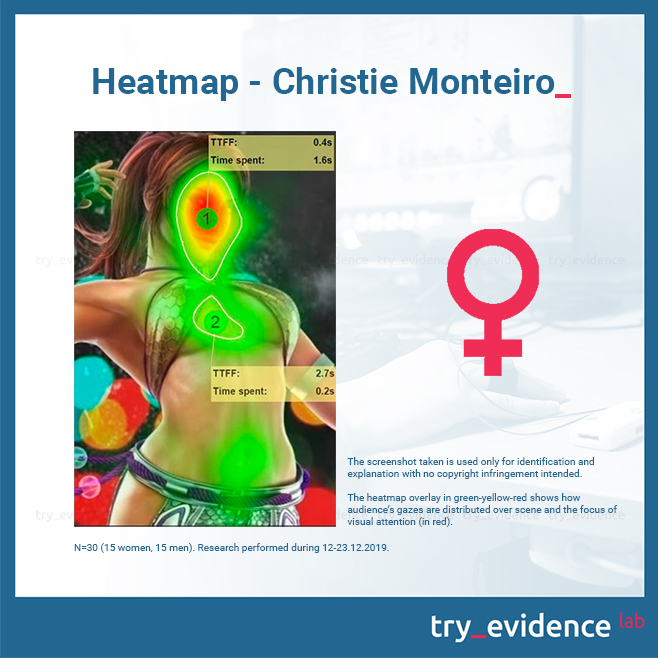
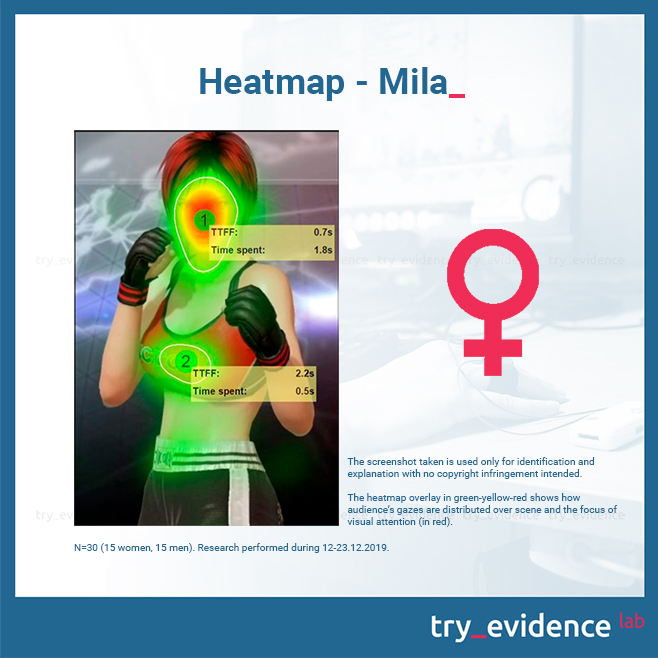
Which qualities of men and women do we appreciate in games, and which ones do we appreciate in real life?
We also conducted standard interviews with the respondents. We asked them about their preferences regarding the appearance and behavior of real women and men. We checked what features they find attractive, and then verified whether the declared real world preferences of players are reflected in their preferences for game heroes.
What do young people pay attention to in newly met women and men?
Both sexes declared they pay the most attention to women’s faces. The surveyed men also focus on the way the woman speaks, what she wants to say and how it feels to talk to her. That, at least, was what they told the Try Evidence researcher. Women emphasized that it a woman should be nice and warm and avoid profanity when speaking.
All respondents claimed to pay attention to the height of newly met men. For men, it was important whether the other man is taller or not. The surveyed men paid more attention to the way the man speaks, how mature he is, and what sense of humor he has. Women said that in men they mostly valued self-confidence, attitude towards others and the quality of being a gentleman.
Features of attractive men and women
Our research shows that the ideal woman should be athletic, slim, tall (1.70 m) and have long hair and large eyes. This coincides with the findings of the evolutionist David Buss presented in his seminal book Evolution of Desire. In addition, the women respondents appreciated other women’s attention to appearance and clothing. On the other hand, men talked about pretty buttocks and delicate facial features as the key criteria for women’s attractiveness. Eye color is particularly important to them – most men preferred vivid colors such as blue and green.
Both women and men consider femininity as an attractive feature, but define it differently:
Women value in other women delicacy and a lack of profanity in the language, but alongside strength and confidence; while men appreciate women’s care, sensitivity and modesty.
Men also value women’s ability to demonstrate intelligence in conversations – interesting topics, broad horizons, a sense of humor, activity and openness to experience.
For both men and women, the ideal man is a determined, brave, open-minded gentleman with a sense of humor.
According to women, a gentleman is someone who is polite, according to men – someone stylish.
Women and men perceive the muscularity of attractive men differently. Women attach more importance to the muscularity of the arms, and men see the general physique – arms, chest, hips and legs.
Do the virtual preferences coincide with real-life preferences of the respondents?
Our study shows that the characteristics of a perfect, attractive male hero in a video game correspond to the respondents’ declared real-world criteria or preferences.
The ideal man is a tall, well-built, has sharp facial features and well-groomed facial hair. He is also courageous and confident.
According to both sexes, a man in the real world must meet higher character trait requirements than a video game hero. It is not easy to meet the expectations of players. An attractive man in the real world must be determined, open-minded, resolute, chivalrous and should have a good sense of humor. While experience and age often appeared in women’s descriptions of a perfect video game hero (the ideal age being about 40 years old), these two features were overlooked in respondents’ declared real-world preferences.
We noticed the same relationship in the case of attractive heroines – a perfect heroine should share many of the characteristics of a perfect real-world woman.
An ideal heroine for both men and women is an athletic, slim and tall (1.70 m) woman with long hair.
In the real world, however, an ideal woman must display different character traits than her gaming counterpart. A flesh-and-blood woman must be nice, intelligent and gentle. Confidence and strength are important in women’s declarations – both for video game heroines and real-world women. In men’s declarations, however, confidence is only a coveted feature of gaming heroines. Apparently, outside games men prefer women who are slightly less dominant.
The must-have features of attractive heroes and heroines
When asked about the features of attractive heroes and heroines, our subjects mentioned both physical attractiveness and personality traits.
An attractive female character in a computer game is a woman around 20 years old who has a shapely body and exudes confidence.
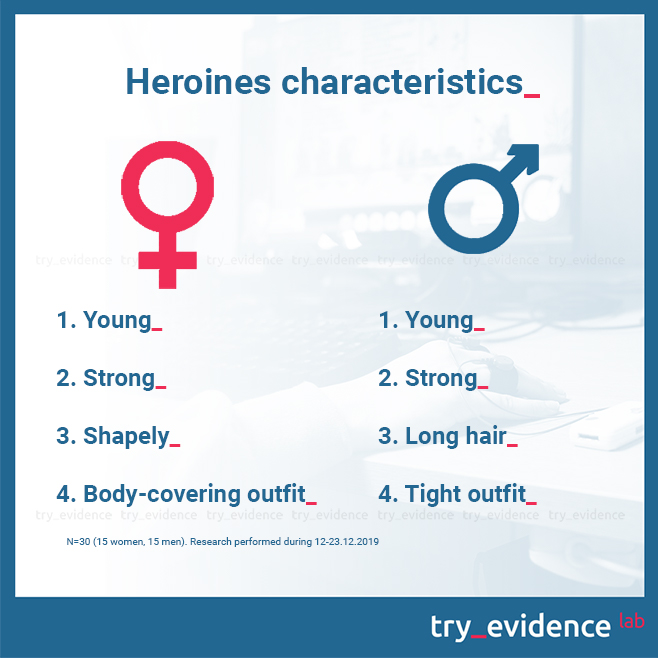
An attractive video game hero is a confident and muscular man aged about forty.
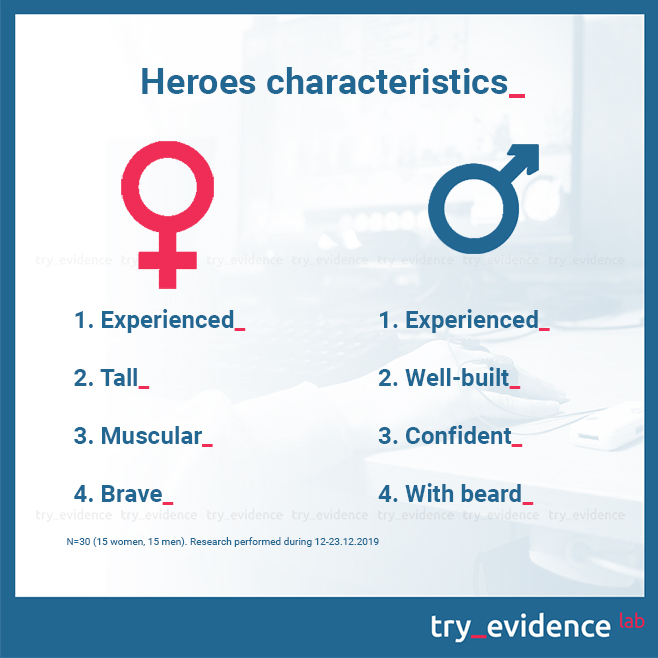
***
The Witcher (x2) did it again! Our study shows that Geralt was not only most attractive but also most stimulating, most engaging and most masculine. It seems we employed a complex research procedure to bring you yesterday’s news – Geralt of Rivia is a well-designed character in every respect.
It thus seems that players are apparently aroused mainly by stereotypical male warriors. Joel from The Last of Us, who is also an interesting figure, excited the subjects the least. For video game heroes, masculinity prevails.
The women’s world is more nuanced. Both the delicate Kokoro (mostly a stereotypically feminine role) and the aggressive Juri (a stereotypically masculine role) were almost equally stimulating or stimulating to the examined players.
Interestingly – as probably expected by some of our readers – engagement and excitement do not always go hand in hand in computer game heroes. When playing or watching video game content, facial expressions and physiological responses do not often match the respondents’ declarations. Respondents are not always willing to openly declare their preferences regarding attractiveness. That is why – to obtain a full picture of the phenomena studied – it is important to use information collected using at least two methods, i.e. with the so-called triangulation technique. In the qualitative practice employed at Try Evidence, this involves interviews and surveys combined with simultaneous measurements and analysis of psychophysical reactions.
The results of the study of heroes and heroines have shown that for both in video games and in real-life, the criteria for a hero are really high. Both in the virtual and real world, they must meet many exaggerated personality and image expectations. The sets of obligatory appearance and character traits of video game heroes and heroines are, in fact, the condensed result of the players’ ideas about femininity or masculinity and heroism. It is not easy to meet them all, although – as we have seen – some „monster hunters” come pretty close.
—
Want to cite this article? Do it in an elegant way:
Dębek, M., Kość, M., Zalewski, D. (2020), Report on the attractiveness of video game heroines and heroes part 2/2, https://tryevidence.com/blog/report-on-the-attractiveness-of-video-game-heroines-and-heroes-part-2-2






